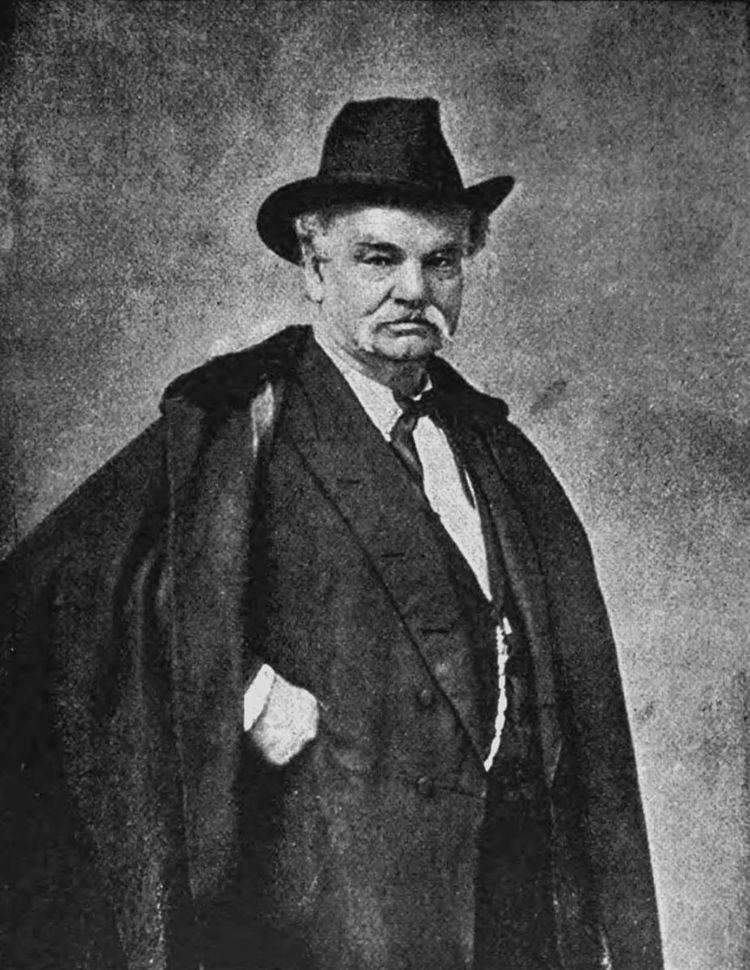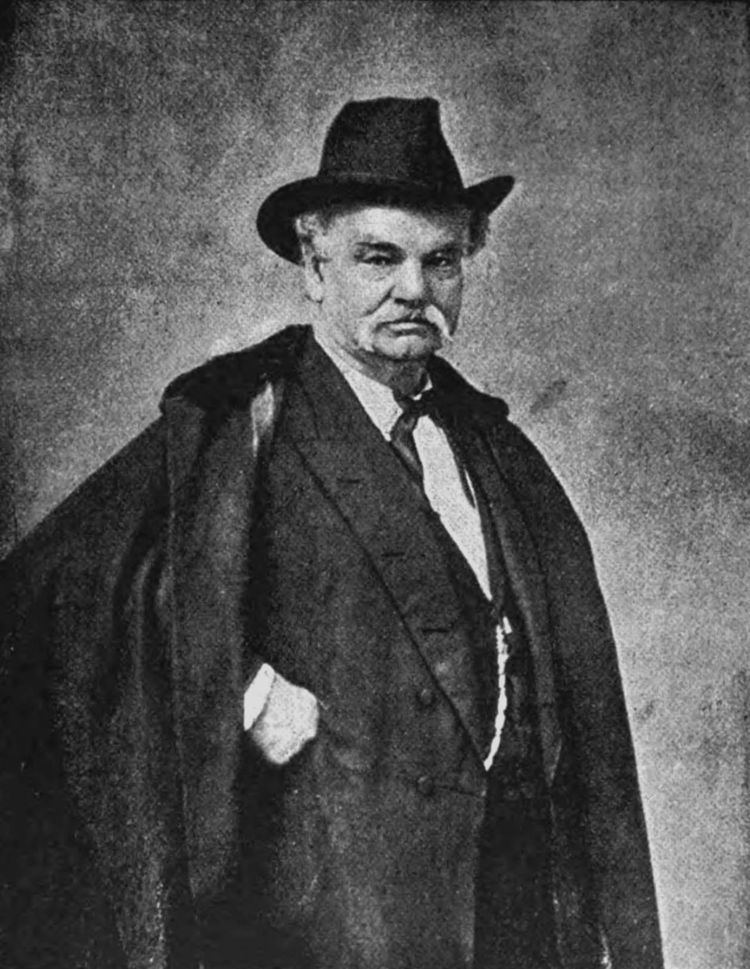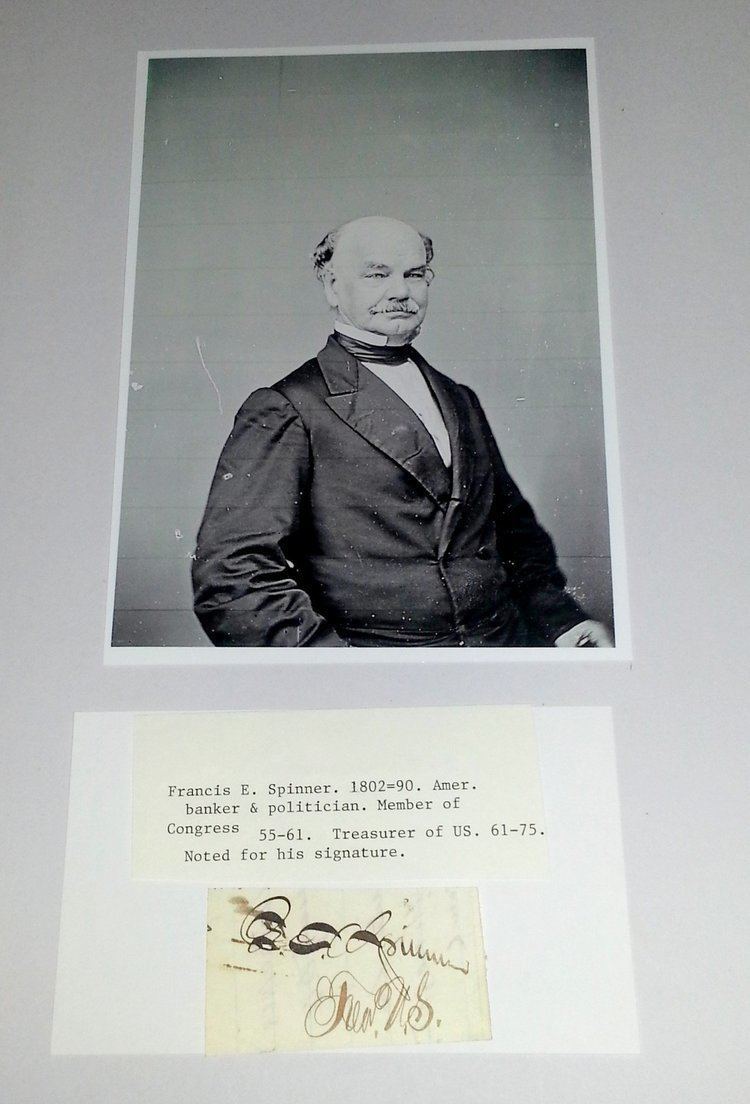Signature Name Francis Spinner | Role Politician Resting place Mohawk | |
 | ||
President Abraham LincolnAndrew JohnsonUlysses S. Grant Born January 21, 1802German Flatts, New York, U.S. ( 1802-01-21 ) Parents Mary Magdalene Fidelis Brument Spinner, John Peter Spinner | ||
Francis Elias Spinner (January 21, 1802 – December 31, 1890) was an American politician from New York. He was Treasurer of the United States from 1861 to 1875. He was the first administrator in the federal government to employ women for clerical jobs.

Life

His father was John Peter Spinner (born in Werbach, Baden, 18 January 1768; died in German Flatts, NY, 27 May 1848), a Catholic priest who became a Protestant, married Mary Magdalene Fidelis Brument, emigrated to the United States in 1801, and was pastor of two German-speaking Dutch Reformed churches, at Herkimer and German Flatts until his death.
Francis Spinner was the eldest of nine children, six sons and three daughters. His father instructed him in languages, and in the common schools of Herkimer County he learned English grammar, reading, writing and arithmetic. His father required Spinner to learn a trade. Francis elected to become a merchant, and for about a year was employed as a clerk in a store. The store failed, and Francis was apprenticed to a confectioner in Albany.
In Albany, Spinner made the acquaintance of some educated men who took an interest in his welfare. Peter Gansevoort allowed him the use of his library. Two years after his arrival, when his father found he was being employed as a salesman and bookkeeper, Spinner was removed from that situation and apprenticed to a saddle and harness maker in Amsterdam, New York. Here Spinner became a shareholder in the circulating library, and studied its volumes when he wasn't busy learning his trade.
In 1824, Spinner moved back to Herkimer County, where he engaged in mercantile pursuits. In 1826, he married Caroline Caswell of Herkimer. He entered the state militia, and by 1834 had risen to the rank of major general. He was appointed deputy sheriff in 1829, and was sheriff of the County from 1834 to 1837. He was appointed one of the commissioners for the construction of the state lunatic asylum at Utica, New York in 1838. When he was removed from this post on political grounds, he engaged in banking, first as cashier and later as president, at the Mohawk Bank.
He was state inspector of turnpikes, and served as commissioner and supervisor of schools. He was appointed auditor and deputy naval officer in charge of the Port of New York in 1845 and served four years.
Spinner was elected as an anti-slavery Democrat to the 34th Congress. An active Republican from the formation of the party, he was re-elected as a Republican to the 35th and 36th United States Congresses, altogether serving from March 4, 1855, to March 3, 1861. He served on the Committee on Privileges and Elections, on a special committee to investigate the assault made by Preston Brooks on Charles Sumner, and on a conference committee of both houses on the Army appropriation bill, which the senate had rejected on account of a clause that forbade the use of the military against Kansas settlers. During his last term (36th Congress), he was chairman of the Committee on Accounts.
On the recommendation of Secretary of the Treasury Salmon P. Chase, he was appointed by President Lincoln as Treasurer of the United States and served from March 16, 1861, until his resignation on July 1, 1875. Within 60 days of his assuming office, the expenditures of the federal government increased dramatically.
He was the first to suggest the employment of women in government offices. During the Civil War, many of the clerks of the Treasury Department joined the army, and Spinner suggested to Secretary Chase the advisability of employing women. After much persuasion, his suggestion was taken up, and he carried it into effect successfully, though not without much opposition. The women were first employed to count money, and later took up various clerical duties. He eventually hired over 100 women, paid them well, and retained them after the war was over.
He signed the different series of paper money in a singular handwriting, which he cultivated in order to prevent counterfeiting. His signature on the “greenbacks” of the United States was the most familiar autograph in the country. The history Spinner gave of his signature was:
“I first practiced it while in the sheriff's office about 1835; I used it while commissioner for building the asylum at Utica, and as cashier and president of the Mohawk valley bank, and for franking while in congress. It was brought to its highest perfection when I was treasurer.”
He resigned his office because of a disagreement over staffing appointments. A new Secretary refused to give him final say over his staff. Spinner thought that, as a bonded officer, he should have control over the appointment of clerks for whose acts he was responsible. When he resigned his office, the money in the treasury was counted. The result showed a very small discrepancy, and many days were spent in recounting and examining the books of accounts, until finally the mistake was discovered.
In 1875, he ran on the Republican ticket for New York State Comptroller but was defeated by Democrat Lucius Robinson. He moved south, and for some years he lived in camp at Pablo Beach, Florida, where he lived a vigorous outdoor life, and also took up the study of Greek. He was survived by one of his three daughters.
He was buried at the Mohawk Cemetery, in Mohawk, New York. After his death, a group of women who worked in the Treasury Department contributed $10,000 for a monument which now stands in Myers Park in Herkimer.
